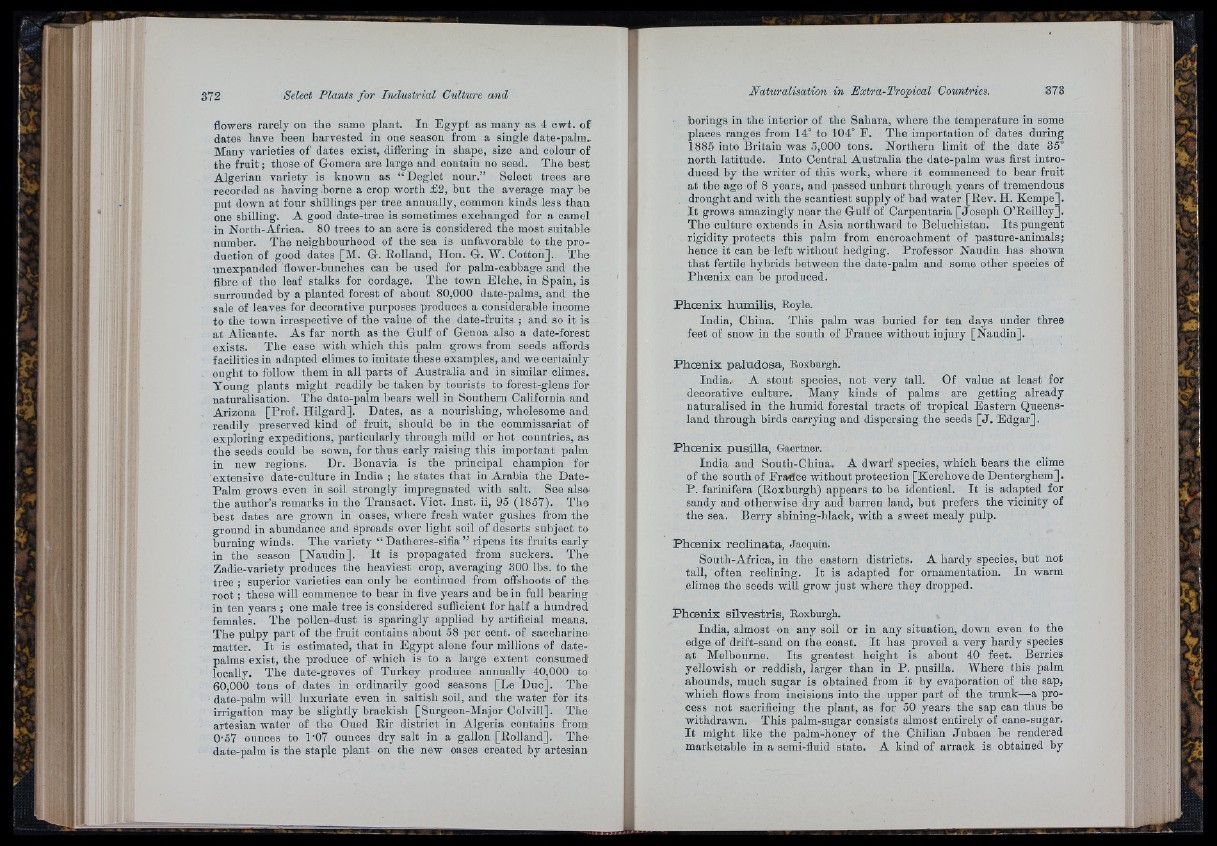
flowers rarely on the same plant. In E gypt as many as 4 cwt. of
dates have been harvested iu one season from a single date-palm.-
Many varieties of dates exist, differing iu shape, size and colour of
the f ru it; those of Gomera are large and contain no seed. The best
Algerian variety is known as “ Deglet nour.” Select trees are
recorded as having borne a crop worth £2, but the average may be
put down at four shillings per tree annually, common kinds less than
one shilling. A good date-tree is sometimes exchanged for a camel
in North-Africa. 80 trees to an acre is considered the most suitable
number. The neighboirrhood of the sea is unfavorable to the production
of good dates [M. G. Rolland, Hon. G. W. Cotton]. The
nnexpanded flower-hunches can be used for palm-cabbage and the
fibre of the leaf stalks for cordage. The town Elche, in Spain, is
surrounded by a planted forest of about 80,000 date-palms, and the
sale of leaves for decorative purposes produces a considerable income
to the town irrespective of the value of the date-fruits ; and so it is
at Alicante. As far north as the Gulf of Genoa also a date-forest
exists. The ease with which this palm grows from seeds affords
facilities in adapted climes to imitate these examples, and we certainly
ought to follow them in all parts of Australia and in similar climes.
Young plants might readily be taken by tourists to forest-glens for
naturalisation. The date-palm bears well in Southern California and
Arizona [Prof. Hilgard]. Dates, as a nourisliing, wholesome and
readily preserved kind of fruit, should be in the commissariat of
exploring expeditions, particularly through mild or hot countries, as
the seeds could be sown, for thus early raising this important palm
in new regions. Dr. Bonavia is the principal champion for
extensive date-culture in India ; he states that in Arabia the Date-
Palm grows even in soil strongly impregnated with salt. See also'
the author’s remarks in the Transact. Viot. Inst, ii, 95 (1857). The
best dates are grown in oases, where fresh water gushes from the
ground in abundance and spreads over light soil of deserts subject to
burning winds. The variety “ Datheres-sifia ” ripens its fruits early
in the season [Naudin]. I t is propagated from suckers. The
Zadie-variety produces the heaviest crop, averaging 300 lbs. to the
tree ; superior varieties can only be continued from offshoots of the
root ; these will commence to bear in five years and be in full bearing
in ten years ; one male tree is considered sufficient for half a hundred
females. The pollen-dust is sparingly applied by artificial means.
The pulpy part of the fruit contains about 58 per cent, of saccharine
matter. I t is estimated, that in Egypt alone four millions of date-
palms exist, the produce of which is to a large extent consumed
locally. The date-groves of Turkey produce annually 40,000 to
60,000 tons of dates in ordinarily good seasons [Le Due]. The
date-palm will luxuriate even in saltish soil, and the water for its
irrigation may be slightly brackish [Surgeon-Major Colvill]. The
artesian water of the Oued Rir district in Algeria contains from
O'o7 ounces to 1'07 ounces dry salt in a gallon [Rolland]. The
date-palm is the staple plant on the new oases created by artesian
borings in the interior of the Sahara, where the temperature in some
places ranges from 14° to 104° F. The importation of dates during
1885 into Britain was 5,000 tons. Northern limit of the date 35°
north latitude. Into Central Australia the date-palm was first introduced
by the writer of this work, where it commenced to bear fruit
at the age of 8 years, and passed unhurt through years of tremendous
drought and with the scantiest supply of bad water [Rev. H. Kempe].
I t grows amazingly near the Gulf of Carpentaria [Joseph O’Reilley].
The culture extends in Asia northward to Beluchistan. I ts pungent
rigidity protects this palm from encroachment of pasture-animals;
hence it can be left without hedging. Professor Naudin has shown
th a t fertile hybrids between the date-palm and some other species of
Phoenix can be produced.
Phoenix humilis, Royle.
India, China. This palm was buried for ten days under three
feet of snow in the south of France without injury [Naudin],
Phoenix paludosa, Roxburgh.
India. A stout species, not very tall. Of value at least for
decorative culture. Many kinds of palms are getting already
naturalised in the humid forestal tracts of tropical Eastern Queensland
through birds carrying and dispersing the seeds [ J . E d g a r].
Phoenix pusilla, Gaertner.
India and South-China. A dwarf species, which bears the clime
of the south of Frafice without protection [Kerohove de Denterghem].
P . farinifera (Roxburgh) appears to be identical. I t is adapted for
sandy and otherwise dry and barren land, but prefers the vicinity of
the sea. Berry shining-black, with a sweet mealy pulp.
Phoenix reclinata, Jacquin.
South-Africa, in the eastern districts. A hardy species, but not
tall, often reclining. I t is adapted for ornamentation. In warm
climes the seeds will grow ju st where they dropped.
Phoenix silvestris, Roxburgh.
India, almost on any soil or in any situation, down even to the
edge of drift-sand on the coast. I t has proved a very hardy species
a t Melbourne. Its greatest height is about 40 feet. Berries
yellowish or reddish, larger than in P. pusilla. Where this palm
abounds, much sugar is obtained from it by evaporation of the sap,
which flows from incisions into the upper part of the trunk—a process
not sacrificing the plant, as for 50 years the sap can thus he
withdrawn. This palm-sugar consists almost entirely of cane-sugar.
I t might like the palm-honey of the Chilian Jubaea be rendered
marketable in a semi-fluid state. A kind of arrack is obtained by